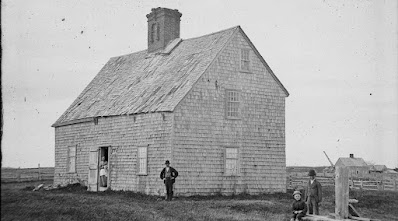After the whaling industry collapsed in the mid-19th century, Nantucket became sparsely populated. There wasn't a lot of economic development on the island, which meant that very few of the old historic houses were torn down to make room for new ones. Those old houses are now mostly vacation homes for the wealthy, but there may be some unexpected guests stopping by to visit, as the following story indicates.
 |
| The oldest house in Nantucket. |
It comes from Blue Balliett's 1984 book, The Ghosts of Nantucket: 23 True Accounts. I bought this at a used bookstore a few years ago, and really enjoy it. It's full of old-fashioned ghost stories, and also has some charming line drawings of old Nantucket houses.
Back in July of 1981, a seven-year old girl named Jesse and her parents were invited to a dinner party at an old house on India Street in Nantucket. The adults were having a great time at the party, but Jesse was the only child there and quickly became bored. To keep her entertained, one of the hosts suggested she take a tally of interesting items in the house: candlesticks, mirrors, brass doorknobs, etc.
The adults could hear her counting in a nearby room counting as they talked and ate dinner. But their dinner conversation was suddenly interrupted when Jesse ran into the dining room, terrified and exclaiming that she had seen a strange man in the house. Her parents and the hosts followed the frightened child into the room where she said she had seen the man, but there was no one there.
Jesse said the man had a very large chin and was wearing a strange, dark blue suit. He had tipped his hat to her and then vanished into thin air. Although she had been scared, Jesse said he seemed friendly. She emphasized repeatedly that he had a long face and very large chin. Since Jesse was safe and unhurt, the adults at the party didn't take her story very seriously. After all, children do have active imaginations.
 |
| Vintage photo from Ebay |
A few weeks went by, and Jesse and her parents had mostly forgotten about her strange experience. One afternoon they were invited back to the old house on India Street, and the owners showed them something they had found in the attic. It was a line drawing that showed people attending a garden party at the house, probably from the 1940s or 1950s.
When Jesse saw the drawing she said, "That's him! The man with the long chin." One of the people in the drawing was indeed a man with an unusually long chin. Some text on the back of the drawing identified everyone in it. The long-chinned man was William Hunt, a previous owner of the old house.
After doing a little research, the current owners of the house learned that William Hunt had committed suicide in 1961, twenty years before he tipped his hat to Jesse.
*****
This is a very satisfying ghost story to me. It has an old house, someone encountering the supernatural, and proof at the end that the encounter was real. That proof is often a major aspect of classic ghost stories. For example, think of phantom hitchhiker stories. Someone always has to independently verify and identify the hitch-hiking ghost. "That girl hitchhiking was my daughter, and she died on this night twenty years ago on the way to her prom. You saw her ghost!" Or this story, from Cape Cod: "That seaweed you found only grows on the bodies of people who drowned. You saw the sailor's ghost!"
In these older, classic ghost stories, someone who did not witness the paranormal encounter has to confirm it was authentic, or someone finds a piece of outside evidence (a piece of seaweed, a drawing, etc.) that confirms the encounter. It's what makes these stories satisfying. If this story just ended with Jesse telling everyone she had seen a long-chinned man it wouldn't quite feel the same.

